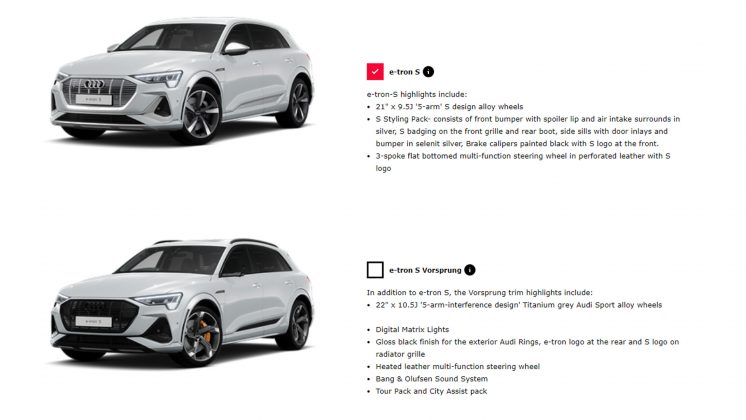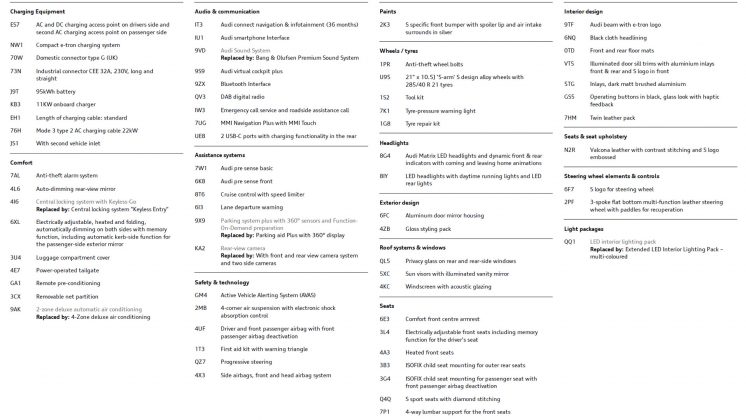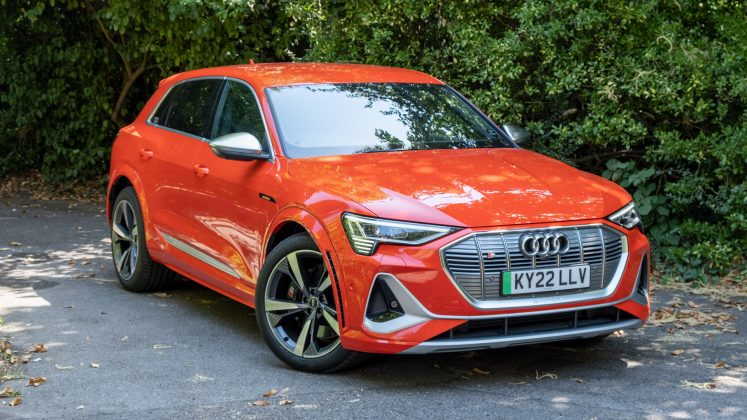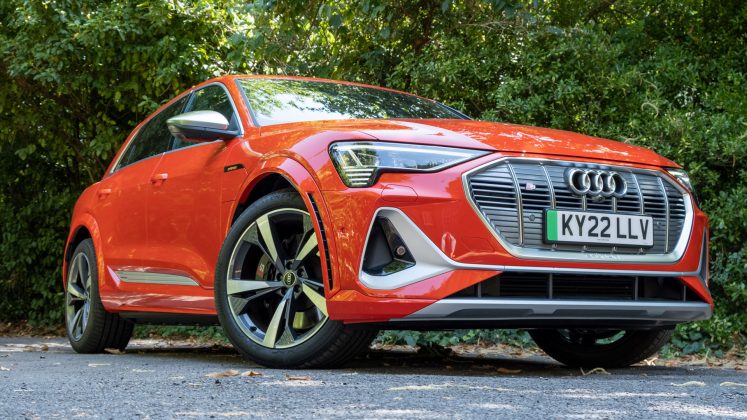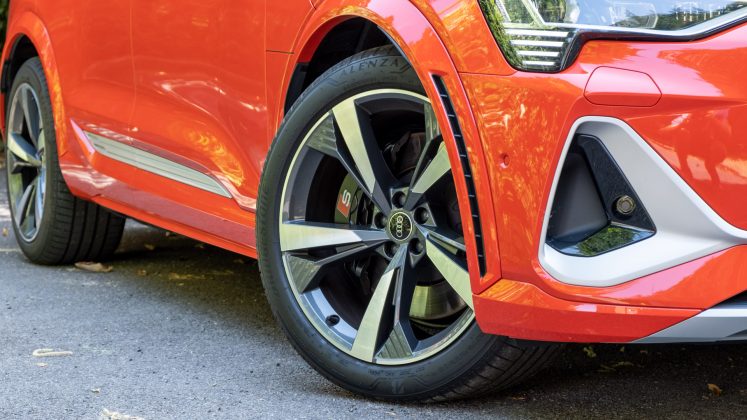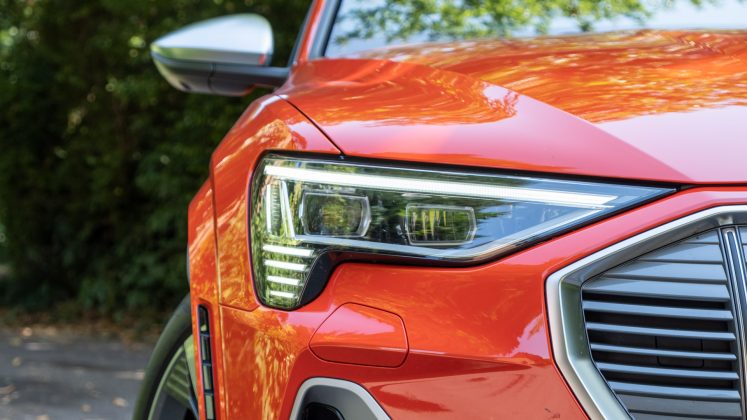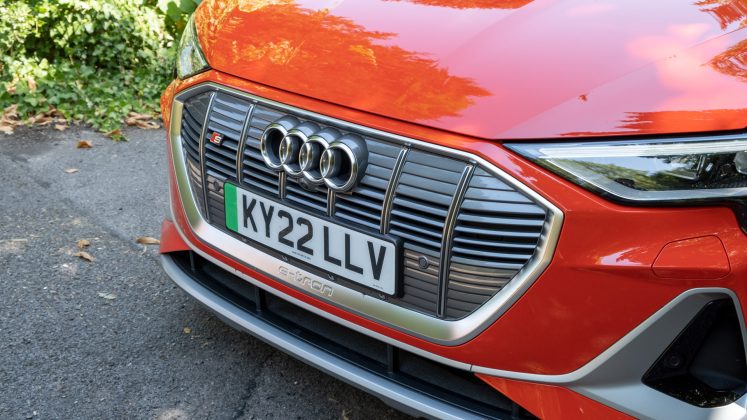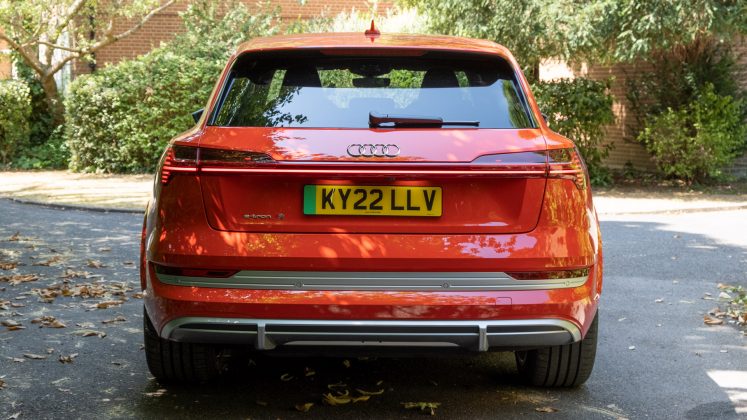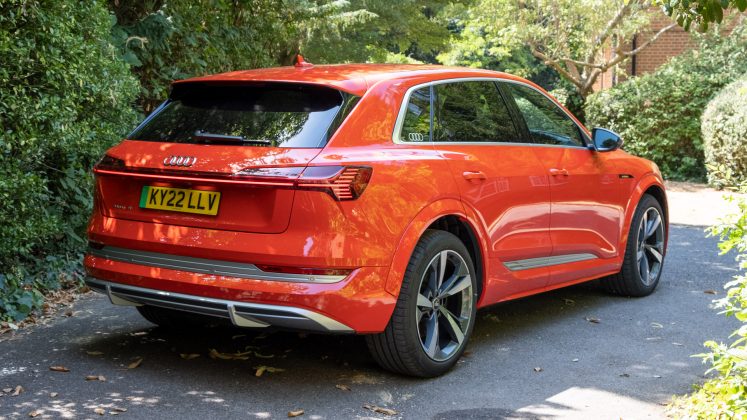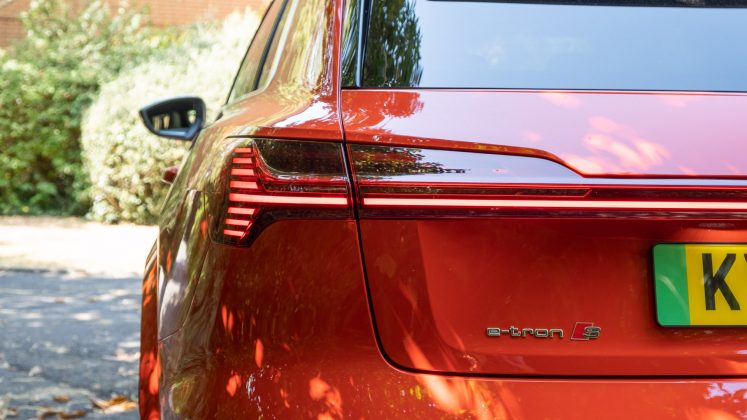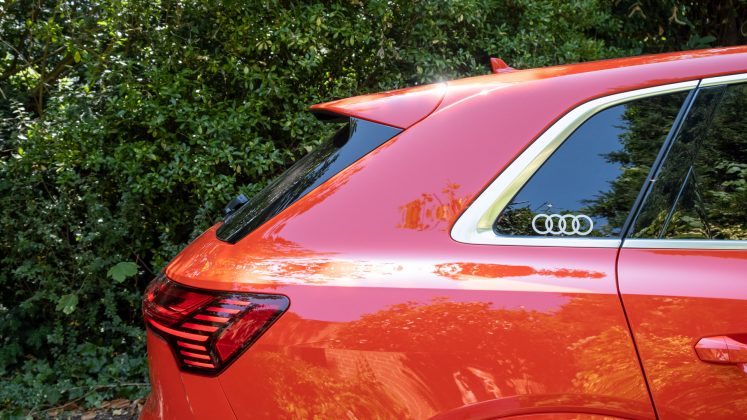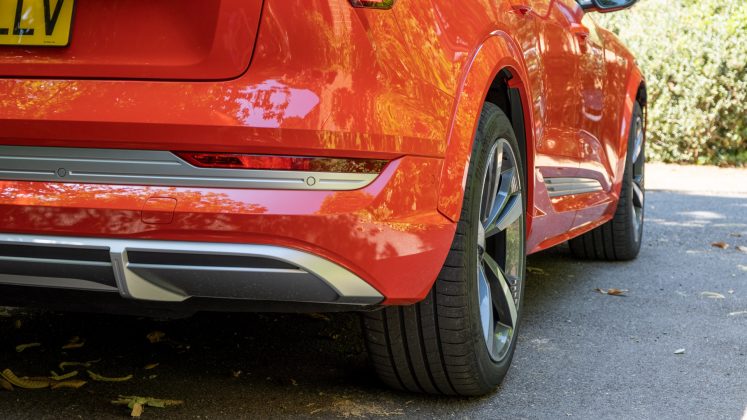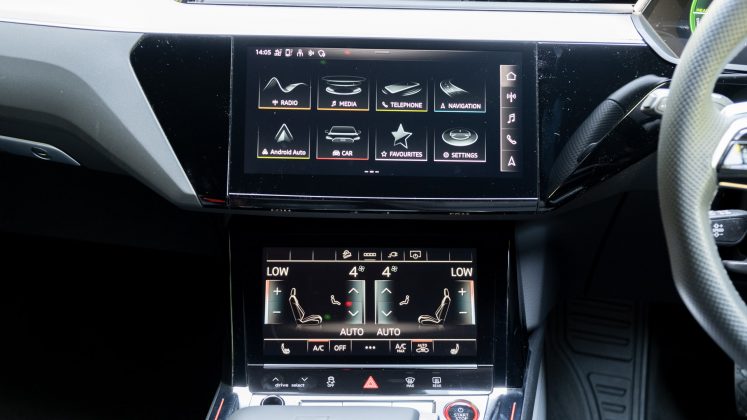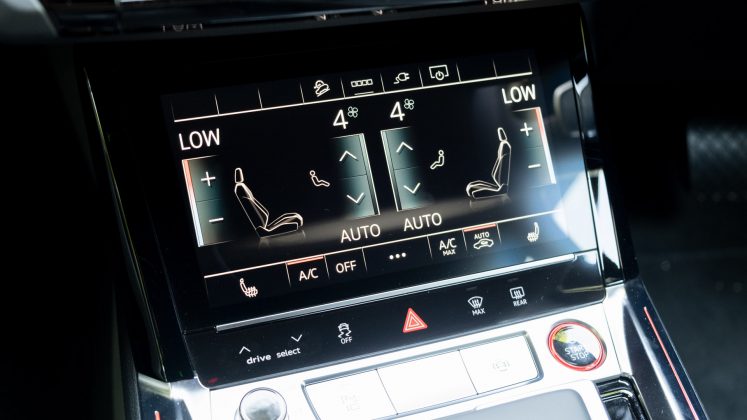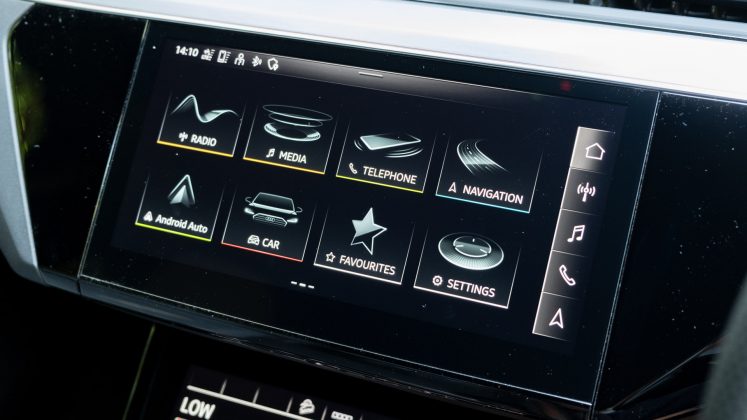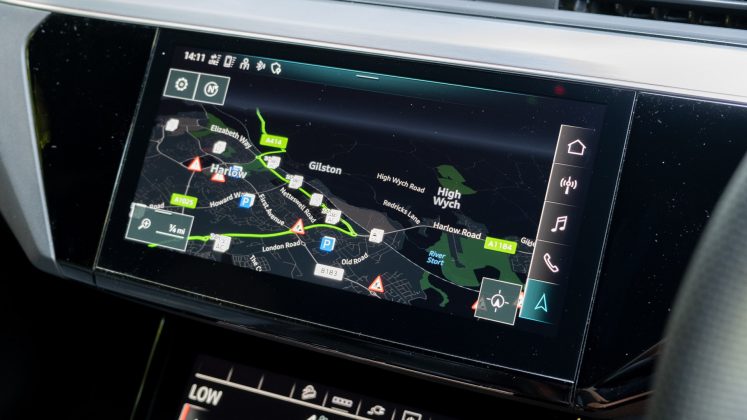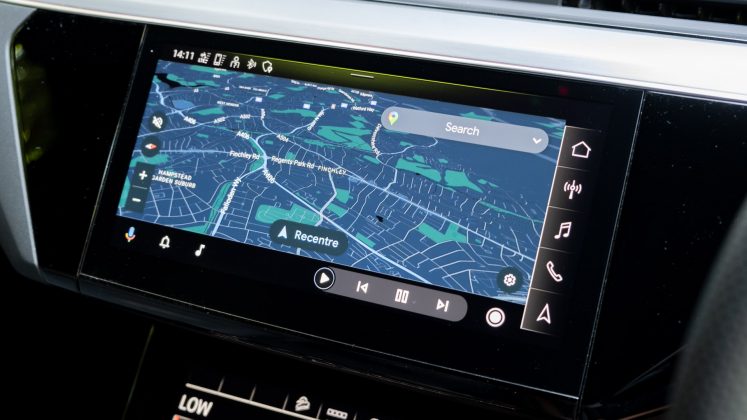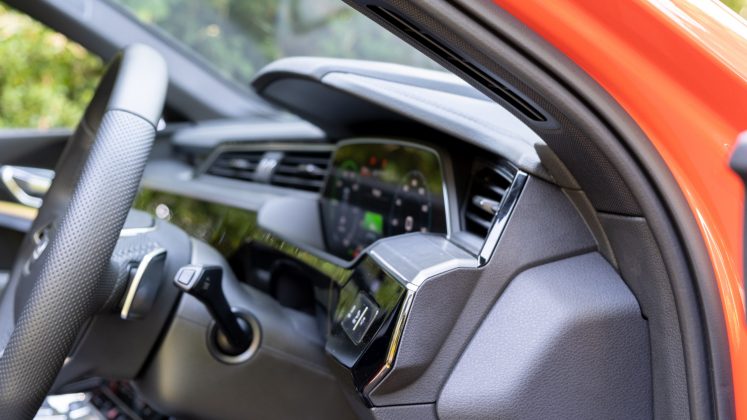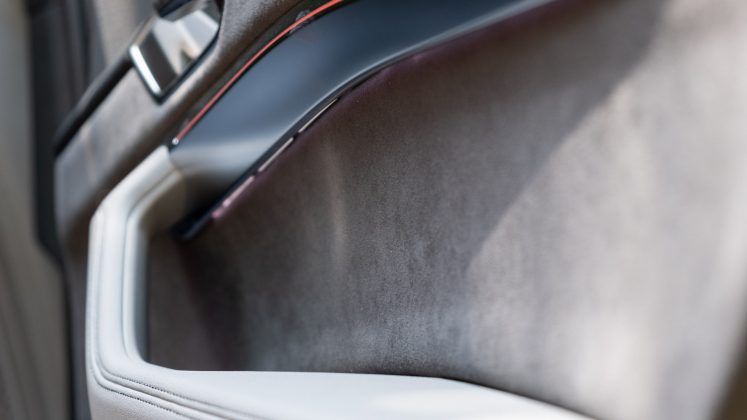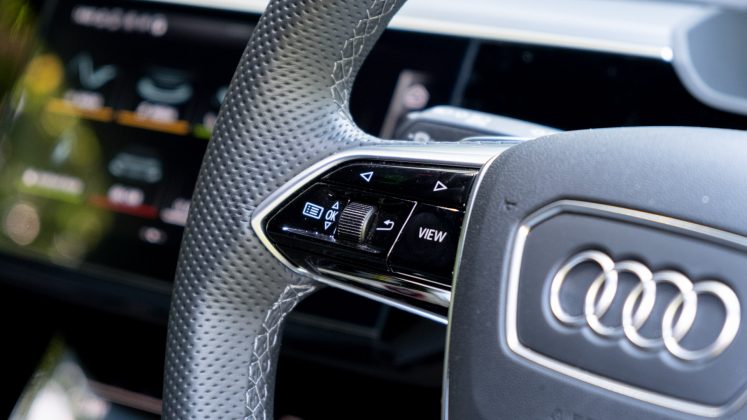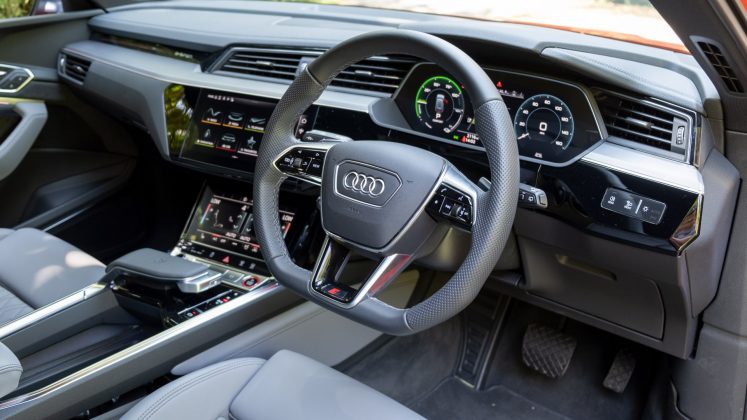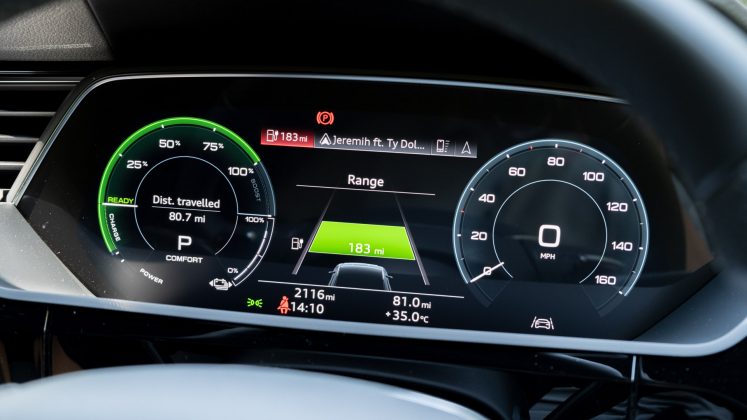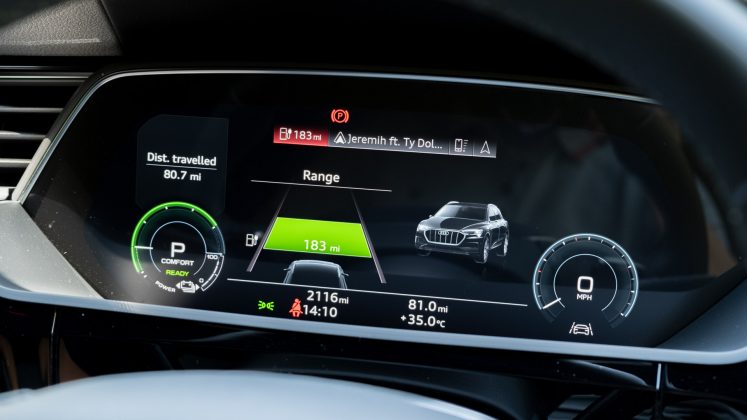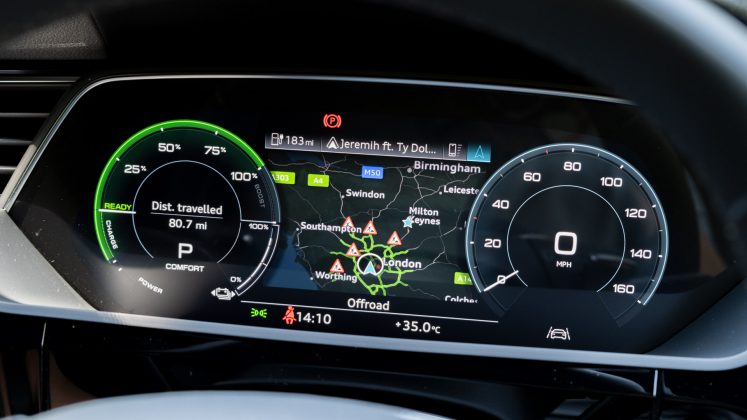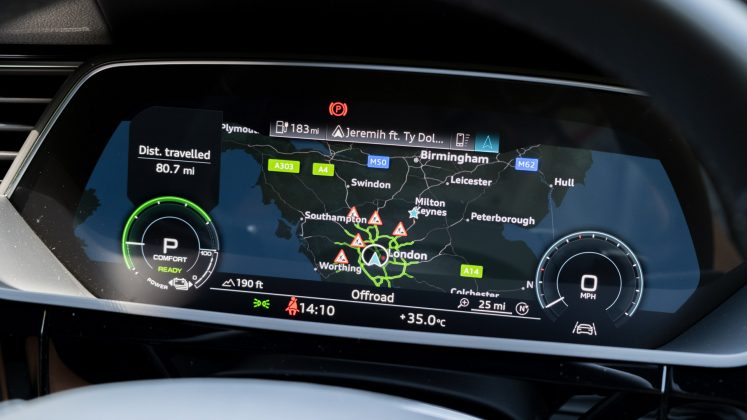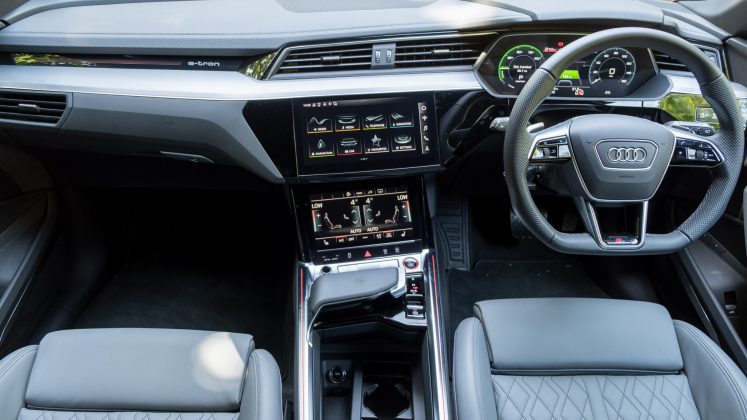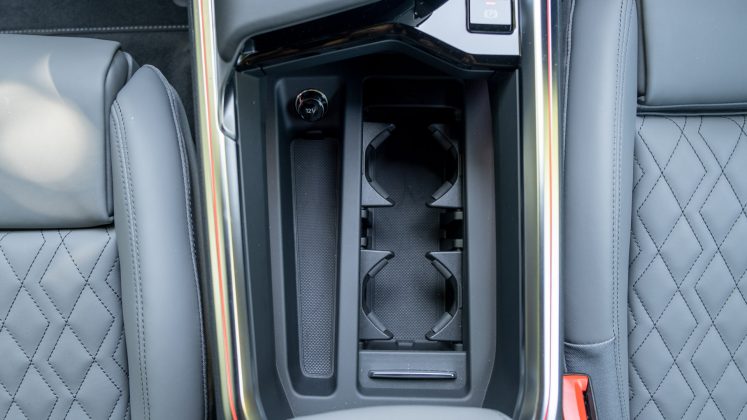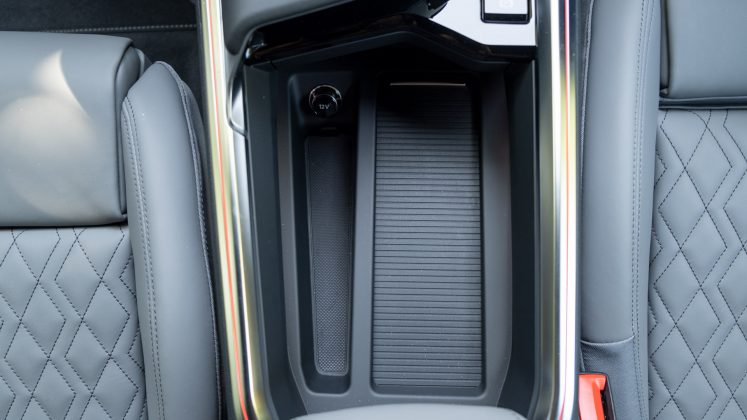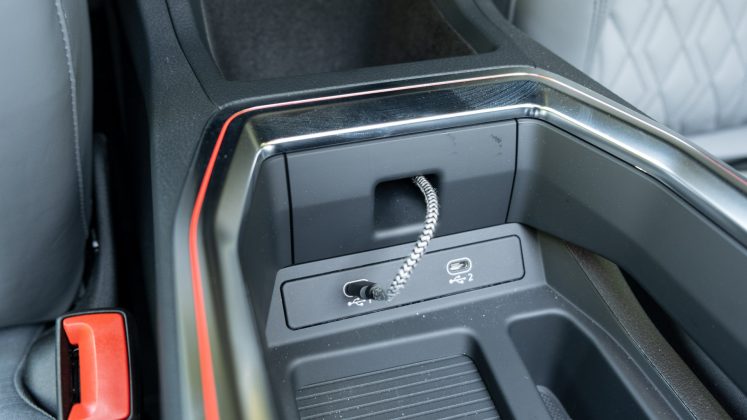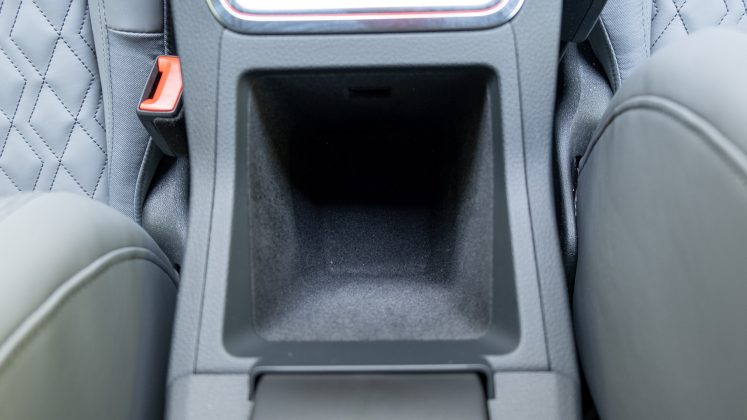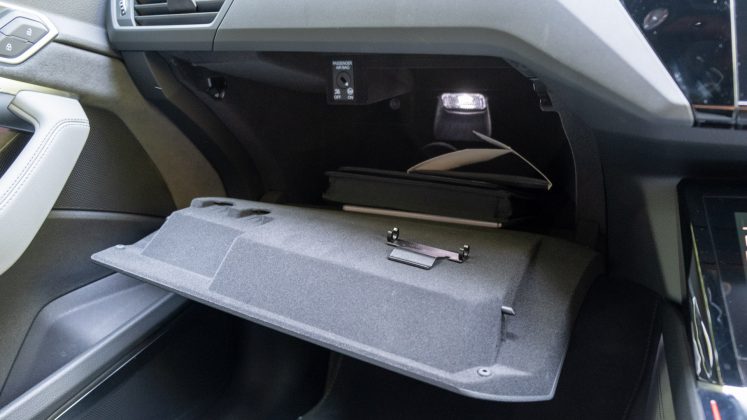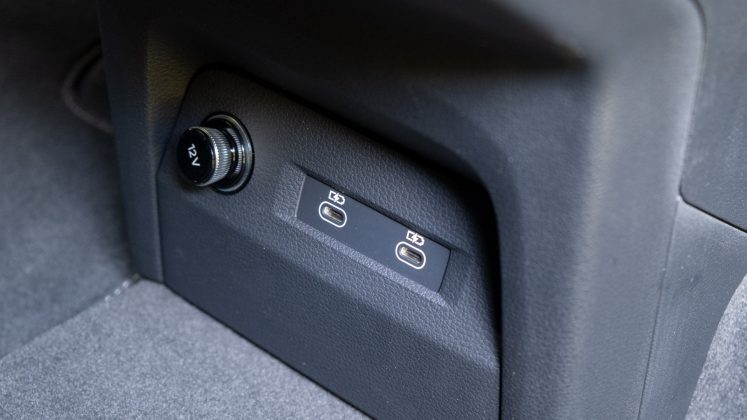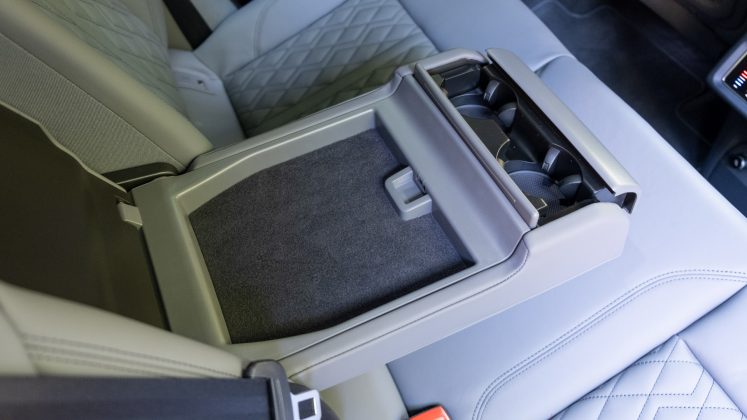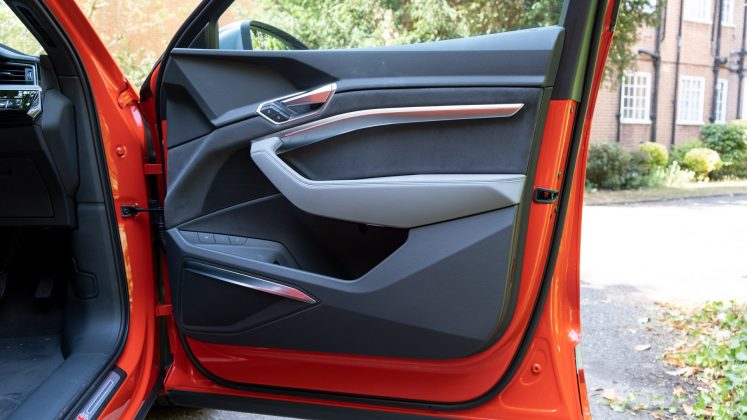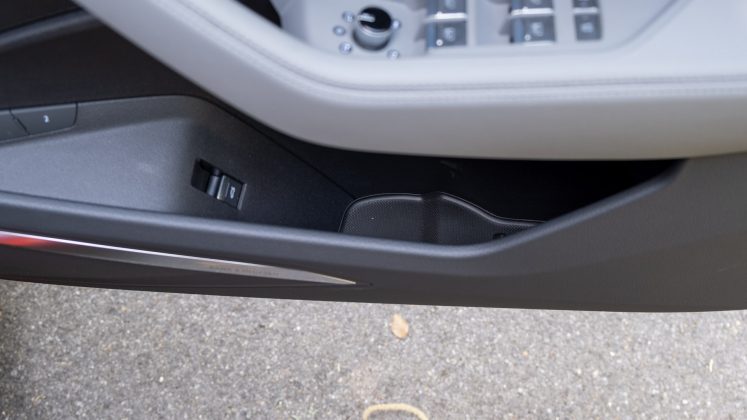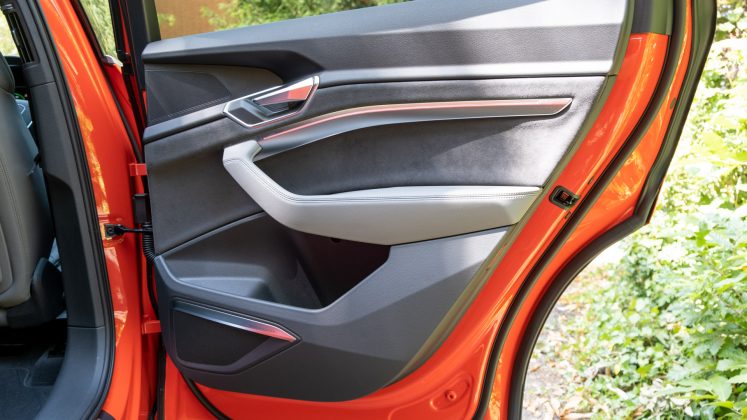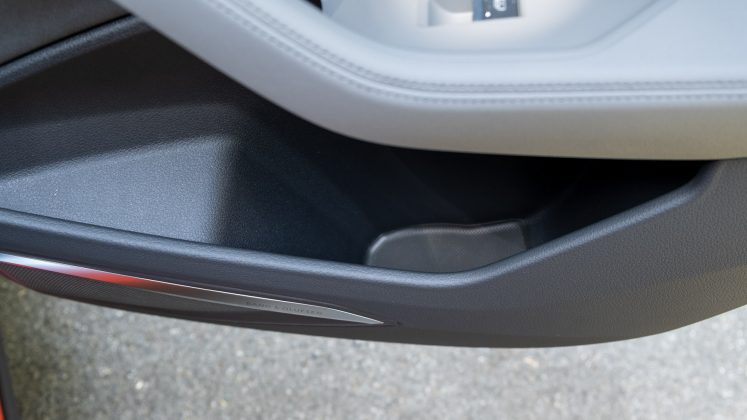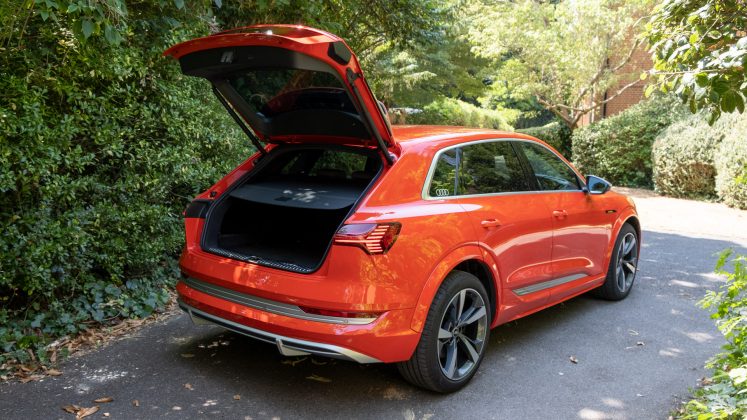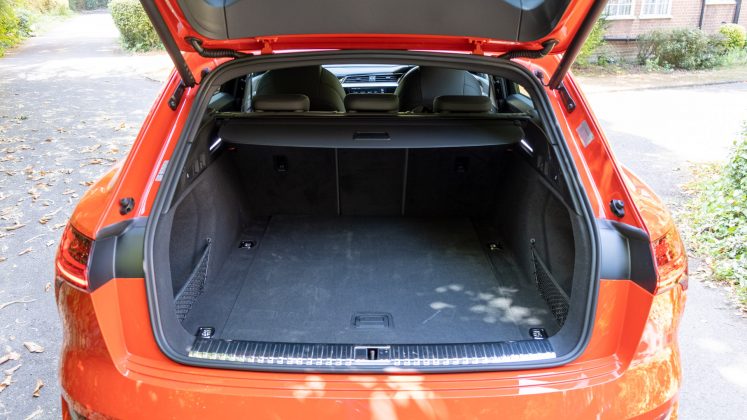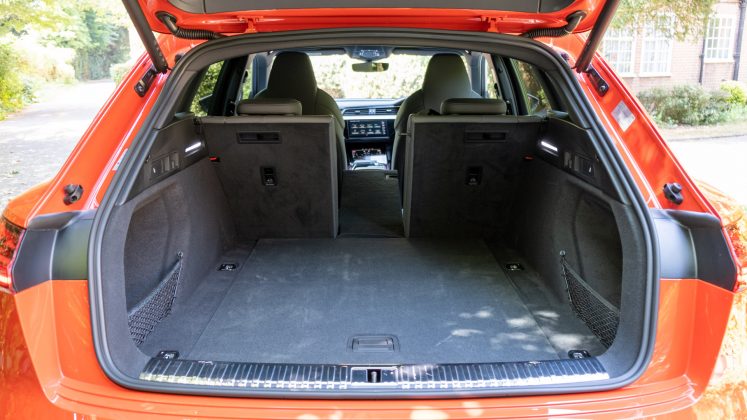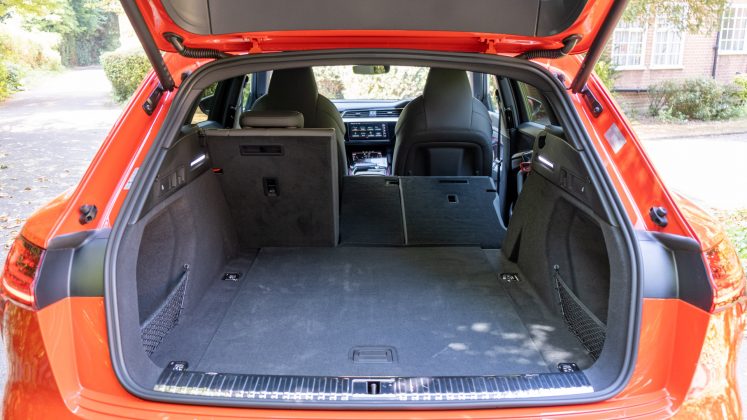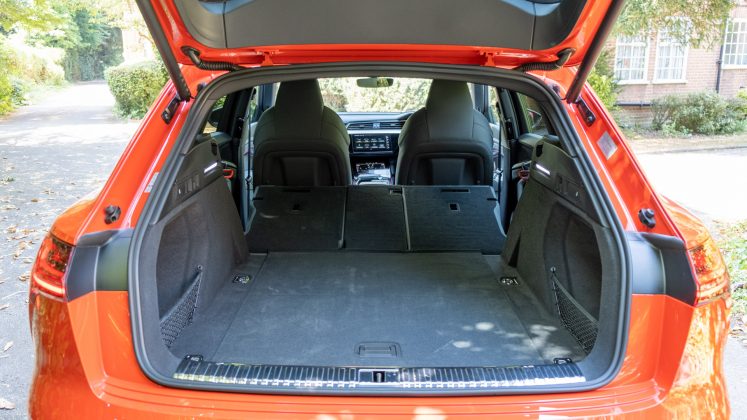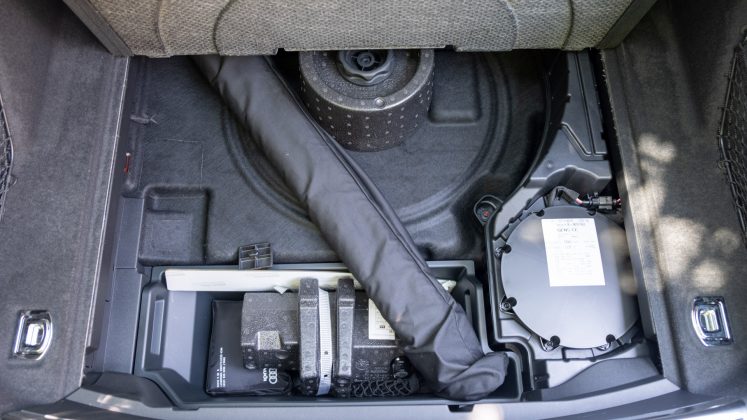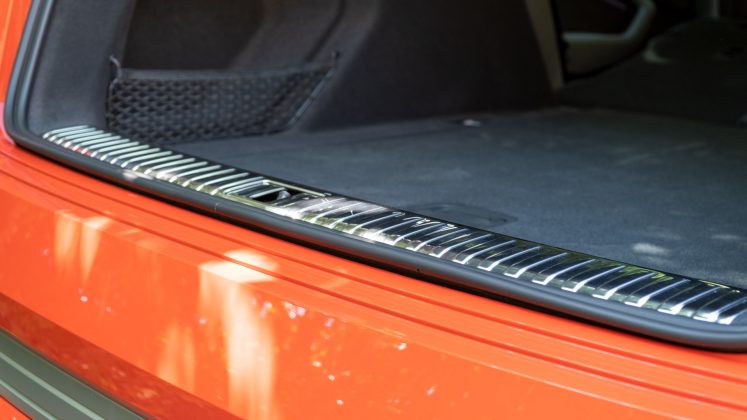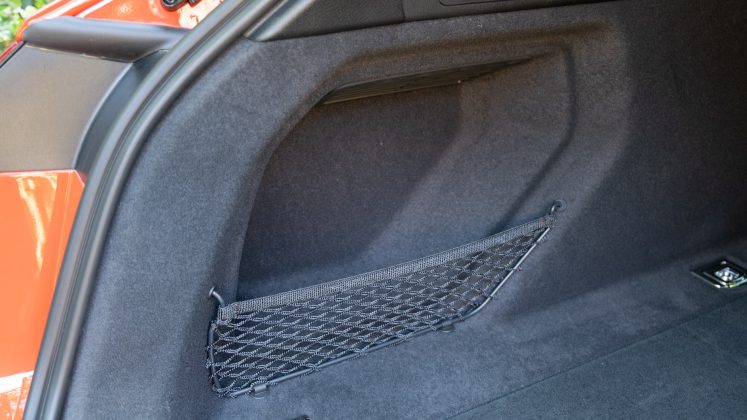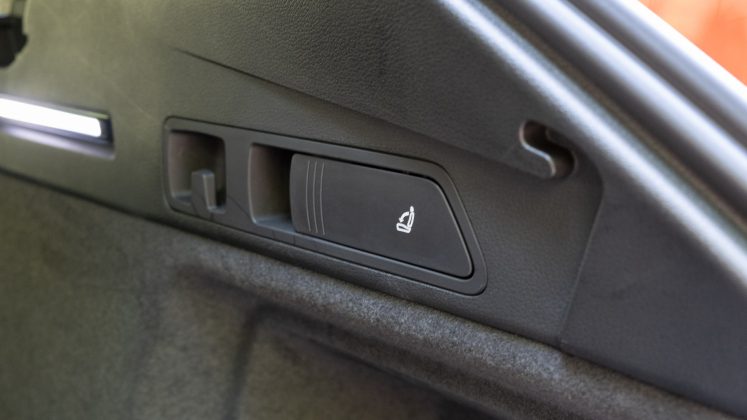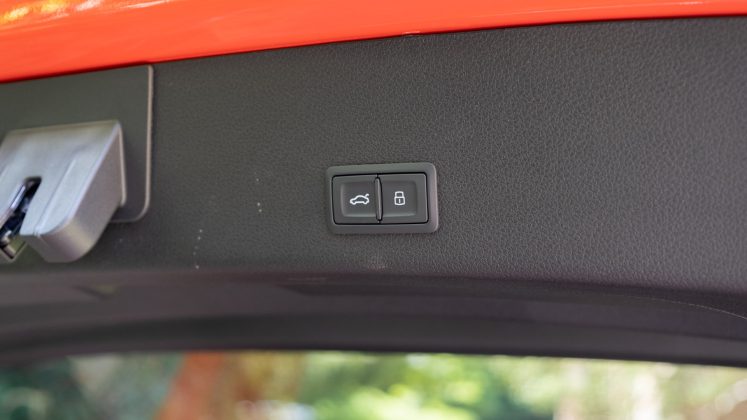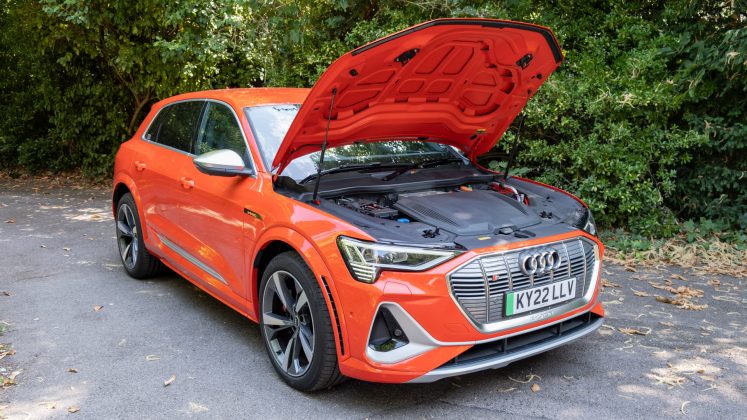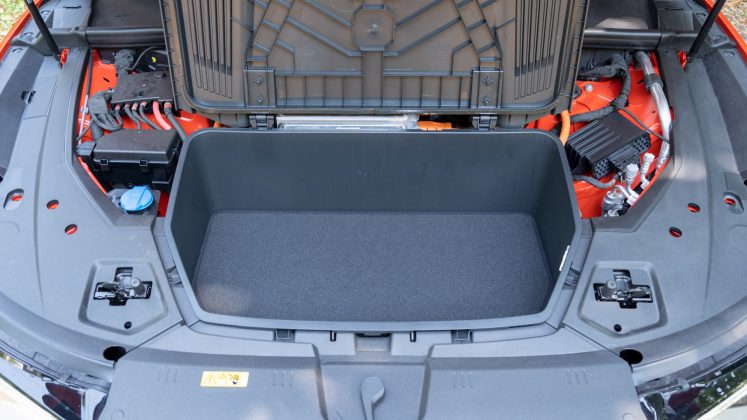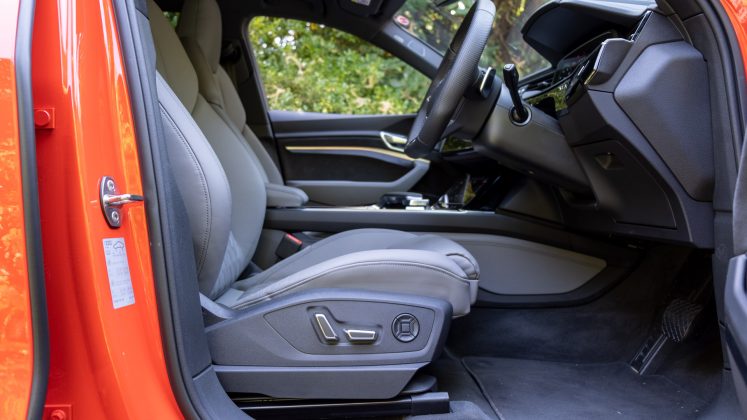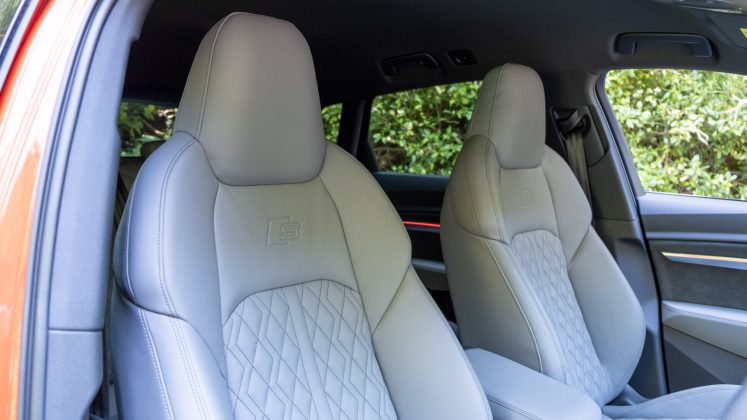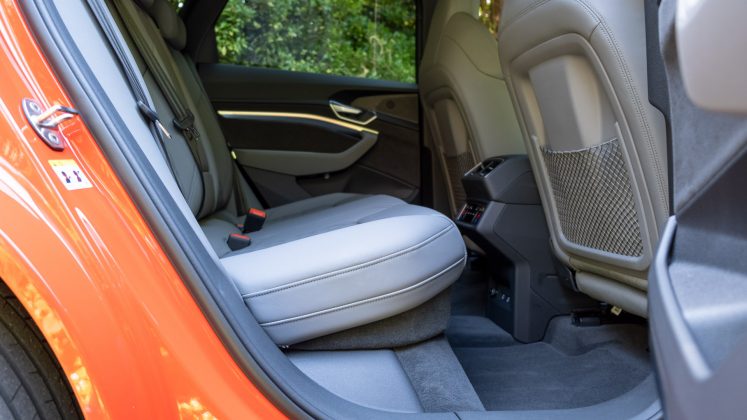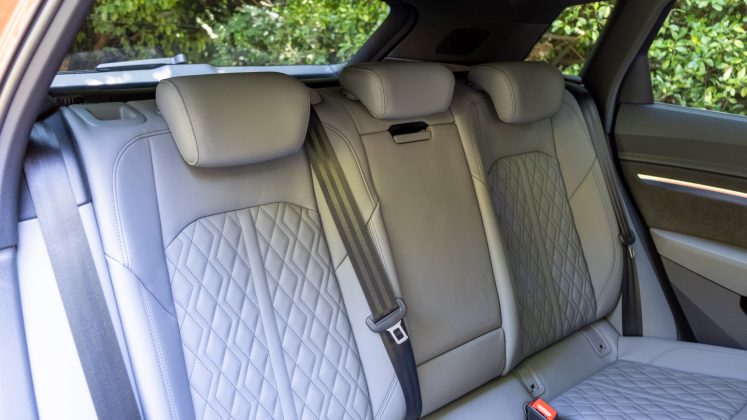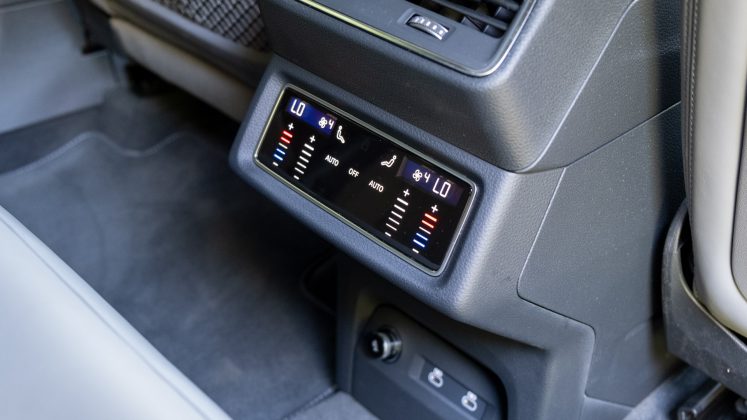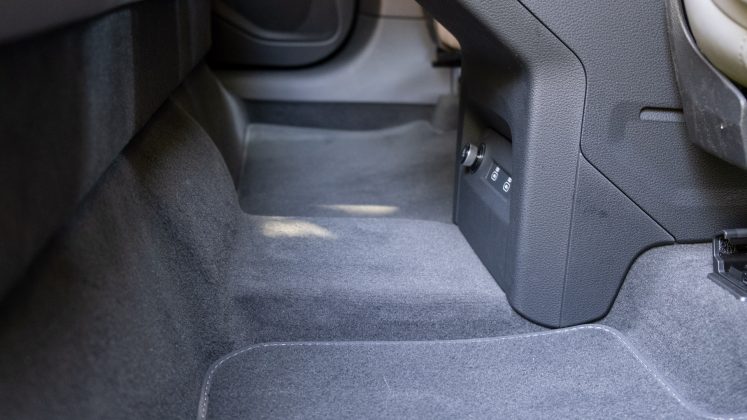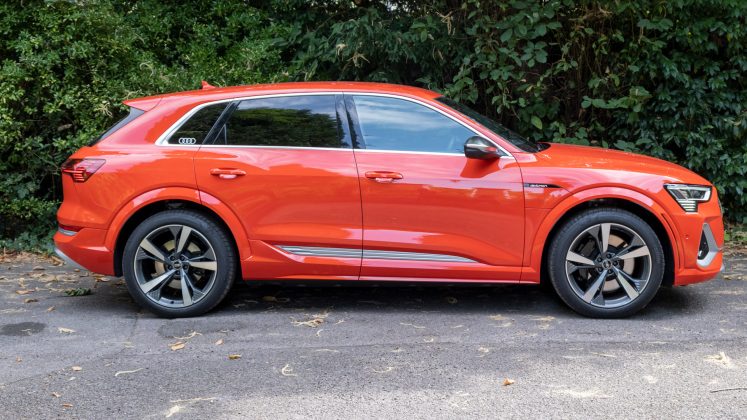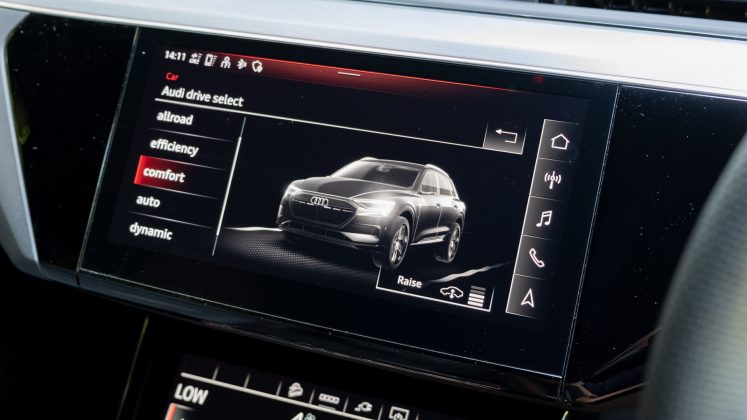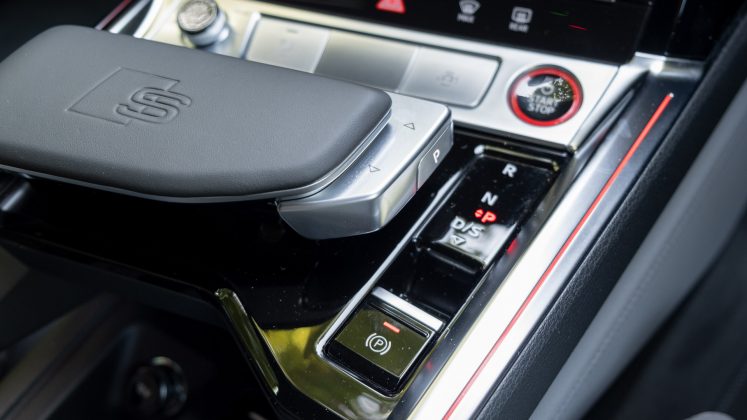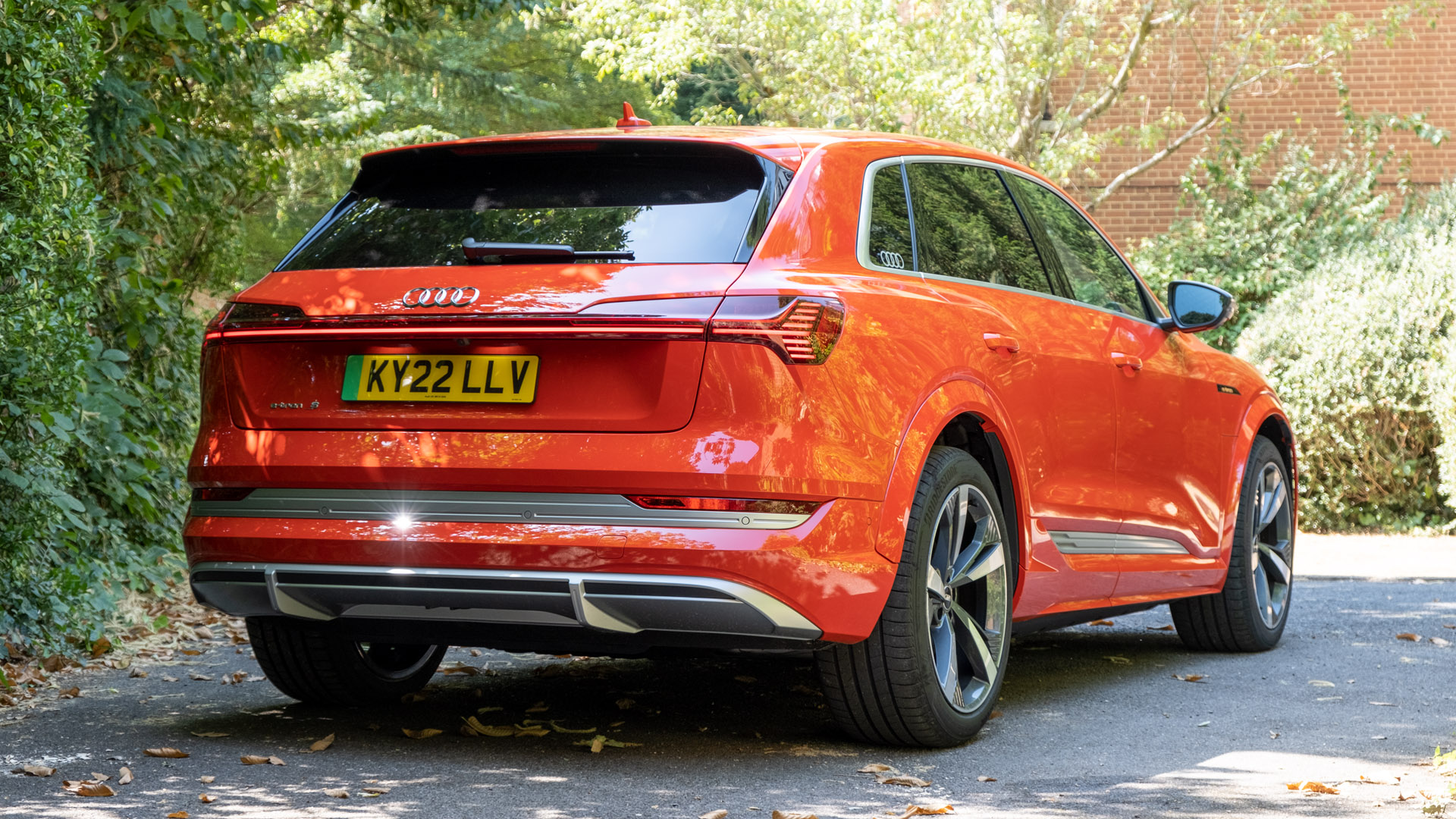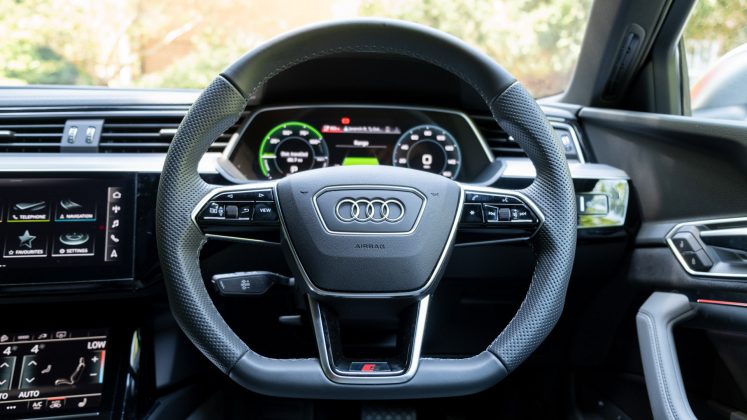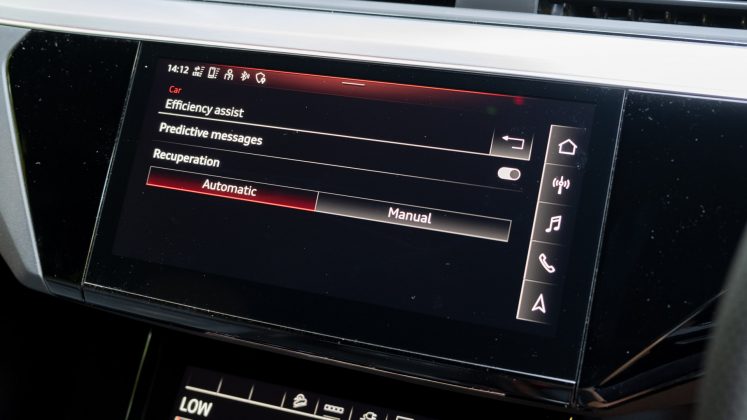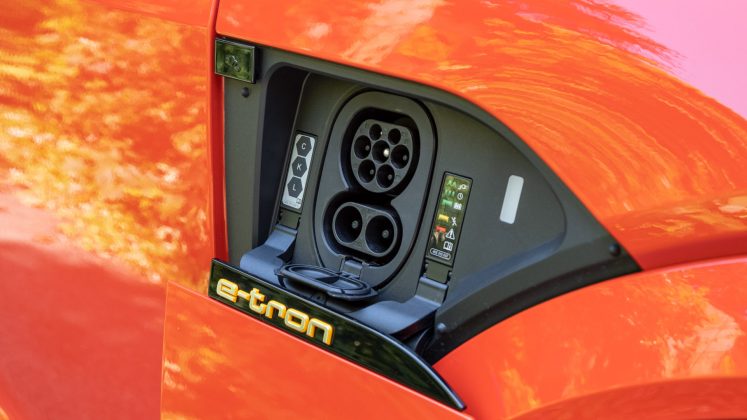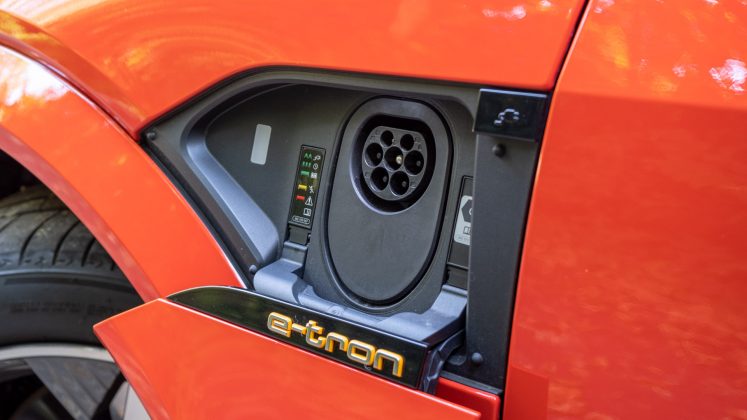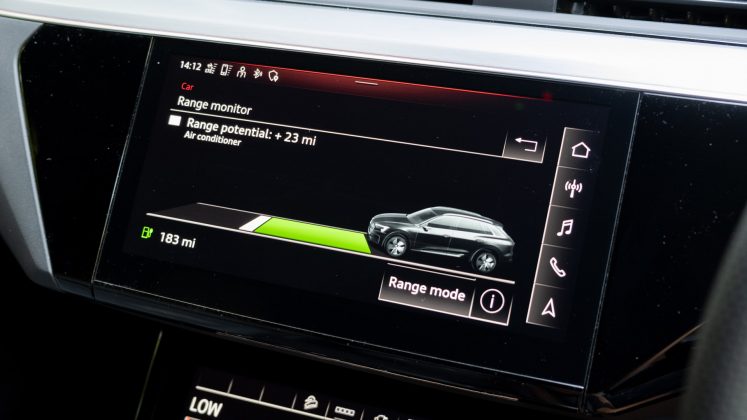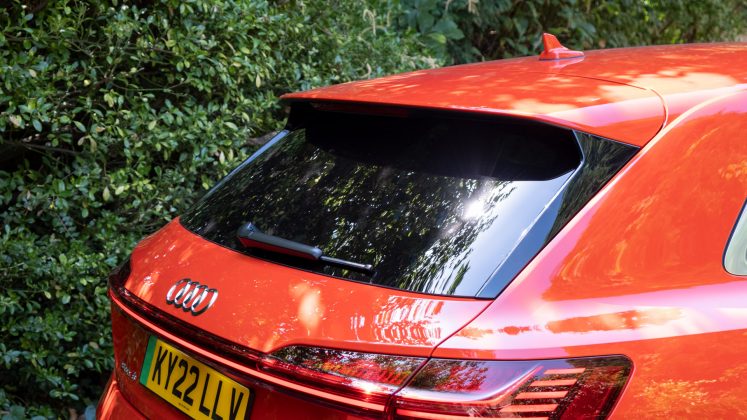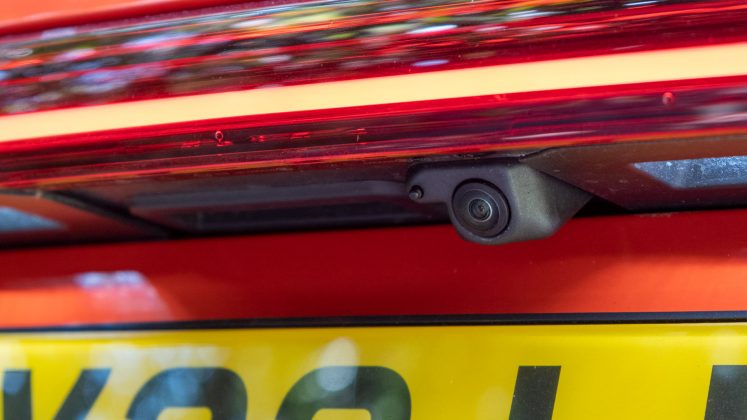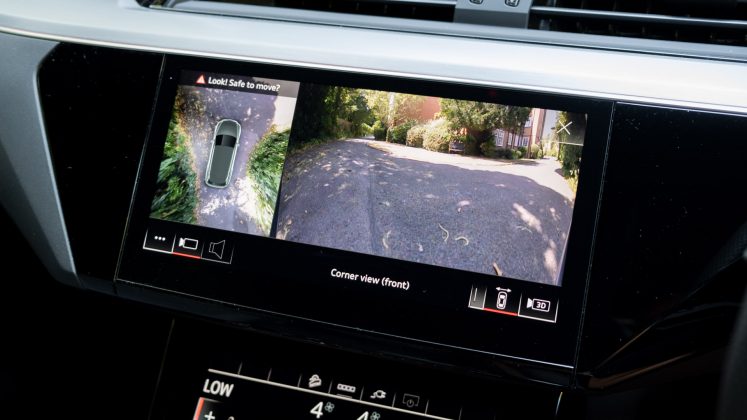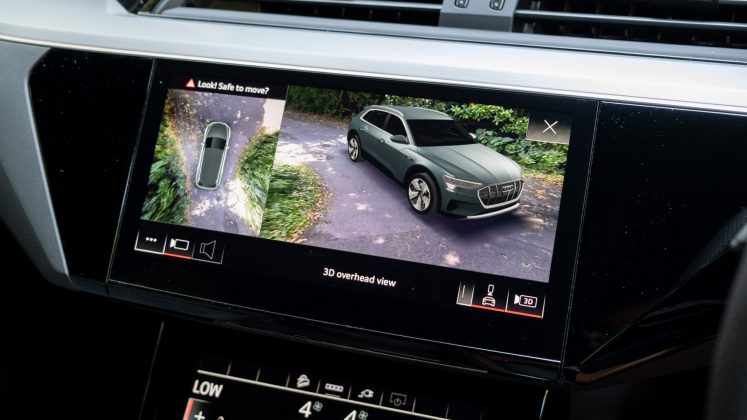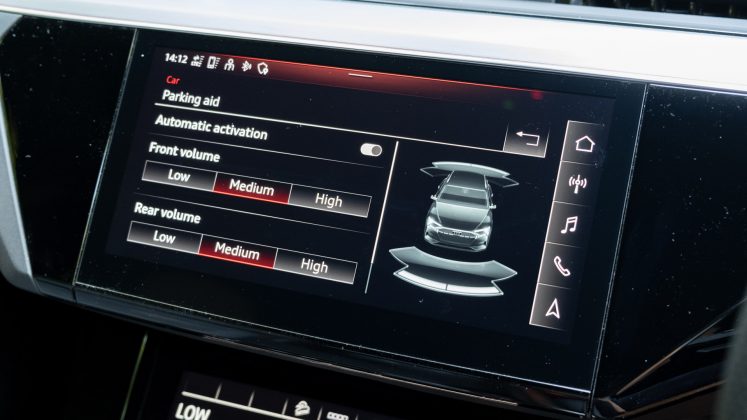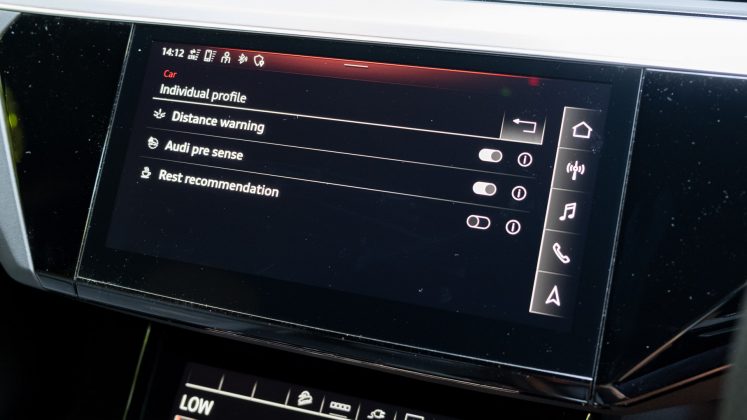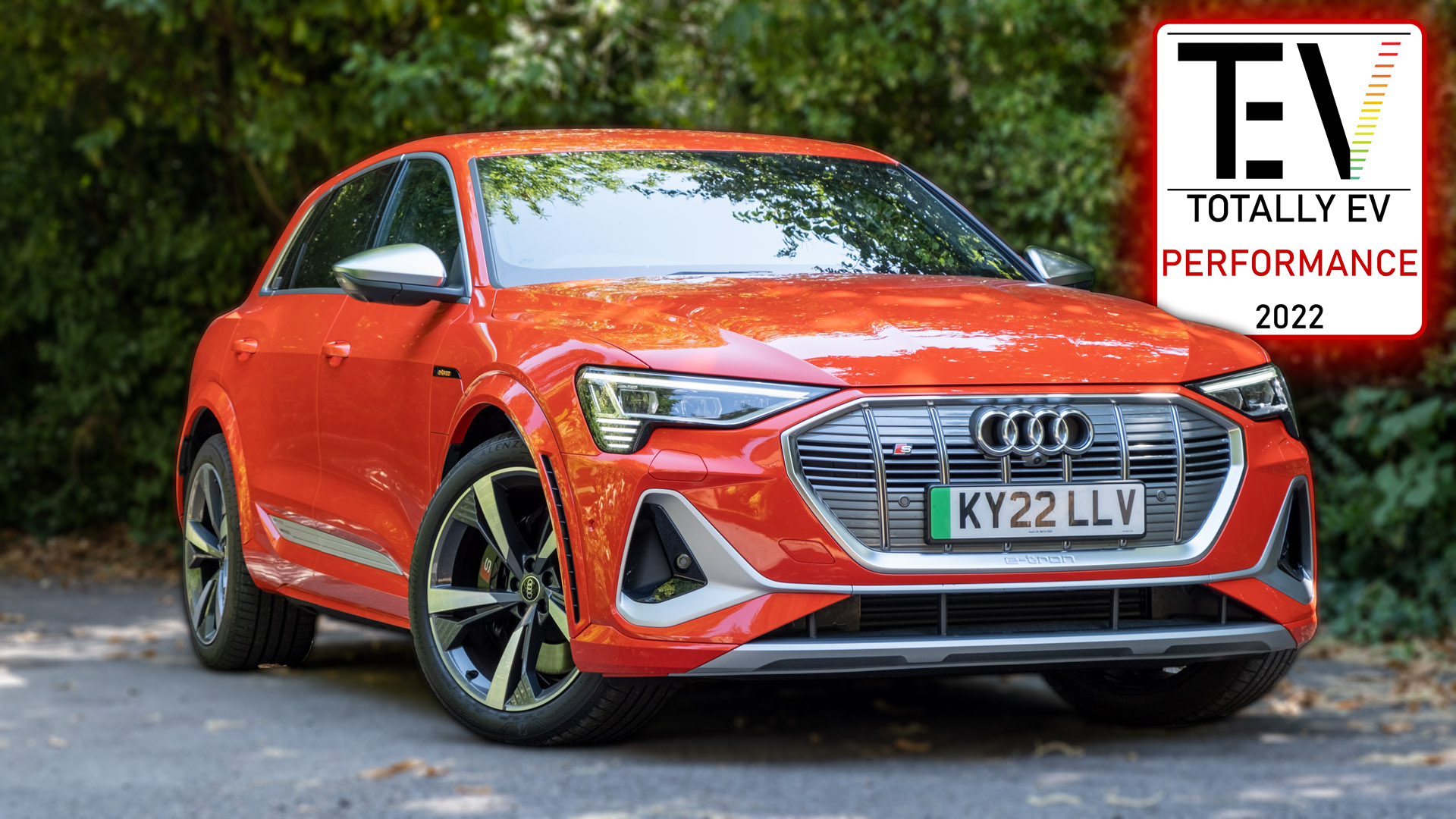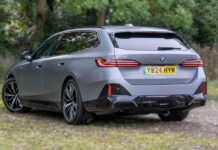The Audi e-tron S is an electric SUV that houses three electric motors. Following the release of the e-tron in 2018, the German automaker added a secondary motor on the rear axel in order to boost the vehicle’s performance.
But, does its triple motor configuration compromise the vehicle’s driving range? In this review, we’ll be comparing the e-tron S to its slower sibling and alternatives from rival manufacturers.
If you’d prefer to watch a review of the e-tron S, head on over to our YouTube channel.
Audi e-tron S price & competition
One main consideration is the asking price. The e-tron S starts from £88,435, with the all-inclusive Vorsprung trim costing £103,635. The latter trim has a few optional packs included and has a few standard options fitted that aren’t available in the regular model, such as a panoramic glass roof, power door closure and a Head-up Display (HUD).
Find the best Audi e-tron deals
Our tested model is the e-tron S with £3,595 of fitted options: Metallic Finish (£750), Comfort & Sound Pack (£1,895), Storage Package (£125) and 4-Zone Deluxe Air Conditioning (£825). A detailed breakdown of the standard equipment can be found below (click to expand) – “Replaced by” is due to the aforementioned packs being included:
As for competition, there are numerous premium all-electric SUVs to consider: the Skoda Enyaq iV 80x from £51,275; the Volkswagen ID.4 GTX from £51,580; the Kia EV6 GT-Line AWD from £51,595; the Hyundai Ioniq 5 AWD Ultimate from £51,900; the Mercedes EQA 350 4MATIC from £53,010; the Audi Q4 50 e-tron from £55,310; the Volvo XC40 Recharge Twin from £56,150; the BMW iX3 from £62,865; its sibling, the Audi e-tron Technik 55 quattro from £73,685; the Jaguar I-Pace from £66,350; the Mercedes EQC 400 4MATIC from £70,035; the Ford Mustang Mach-E GT from £72,830; the Tesla Model X at an estimated £102,980; and the BMW iX xDrive50 M Sport from £107,305.
Read next: Volvo XC40 (C40) Recharge review: A powerful luxury electric SUV
Audi e-tron S exterior review
Despite the vehicle’s steep asking price, the e-tron S is certainly one of the better-looking electric SUVs. At the front, its headlights and accentuated front bumper look the part, while its large-sized grille suits the vehicle’s size – it’s 4,902mm long, 2,189mm wide (1,976mm excluding mirrors) and 1629mm tall.
It’s similarly stylish at the rear with the taillights stretching the width of the vehicle and an integrated spoiler giving it that extra bit of pizzazz. From the side, the 21″ alloys that come fitted as standard (22″ in the Vorsprung model) provide that sporty flair, and the flared side skirts and body-coloured wheel arches complete its look. As for your colour options, black and white solid finishes come as standard but the metallic and pearl colours cost an additional £750 – pictured is Catalunya Red.
Read next: Jaguar I-Pace review: Better than newer rivals?
Audi e-tron S interior review
Step inside, and you’ll find the e-tron S still retains that premium look and feel; from the stitching on the upholstery and steering wheel to the materials used around the cabin. It’s classy and among the most lavish interiors found in an SUV, be it electrified or not.
Moving onto technology, Audi includes a 10.1″ display, which is planted at a slight angle at the centre of the dashboard. The infotainment system is extremely responsive and makes for easy navigation thanks to Audi’s Multi Media Interface (MMI). Should you want, there’s also the ability to enable haptic feedback, which gives you the sensation of pressing a physical button, rather than tapping it virtually.
The same technology applies to the secondary 8.6″ display. The smaller panel, located under the 10.1″ display and conveniently in front of a small wrist rest, is dedicated to climate controls. Here, you’ll be able to adjust the fan speed, temperature and initiate the front-heated seats, which come fitted as standard.
As for the driver’s display, the 12″ instrument cluster provides you with all the key driving information and allows you to see the vehicle’s built-in navigation system. Alas, Android Auto and Apple CarPlay navigation data aren’t fed through to the elongated display. Audi’s MMI supports both third-party operating systems over a wired and wireless connection. The former is preferable for superior audio fidelity.
Speaking of which, the e-tron S comes fitted with a 10-speaker 180-Watt system. Should you want the 16-speaker Bang & Olufsen sound system that outputs 705 Watts, you’ll want to add the £1,895 Comfort and Sound Pack or upgrade to the Vorsprung trim that has this option fitted as standard. If you’d like to know how the B&O system performs, watch our dedicated review of the audio system on YouTube.
It’s worth highlighting that the Head-up Display (HUD), which is present in the more expensive Vorsprung trim, isn’t available as an option in the regular e-tron S. This used to be available as a £1,450 option in the non-S variant but has since been removed.
Read next: Audi e-tron review: Best premium all-electric SUV?
Audi e-tron S storage review
The e-tron S makes up for its HUD omission with a spacious interior design. The door bins can easily accommodate a 500ml bottle alongside small-sized valuables and the glove box is plenty large. Towards the centre console, you’ll find a retractable cover that reveals two cupholders and beside it, a 12V socket to plug in a dash cam or to provide additional power to a smartphone. There are also two USB Type-C ports (data and charging) found in this area.
In terms of practicality, Audi has cleverly cut out a hole by the centre armrest compartment so that you can safely store away your smartphone when it’s plugged in. There are a further two Type-C ports (for charging only) and a 12V socket found by the rear of the centre console. You’ll also find two cupholders and a fabric-lined compartment in the pull-down rear armrest.
What really stands out, however, is the sheer amount of space in the boot. There’s 660 litres with the seats up and a whopping 1,725 litres with them folded down – identical to what you’d find in the regular Audi e-tron.
Here’s how both compare to rival offerings: Tesla Model Y (854/2,100 litres); Skoda Enyaq iV (585/1,710 litres); VW ID.4 (543/1,575 litres); Hyundai Ioniq 5 (520/1,587 litres); BMW iX3 (520/1,560 litres); Jaguar I-Pace (656/1,453 litres); Audi Q4 e-tron (520/1,490 litres); MG5 EV estate (464/1,456 litres); Kia e-Niro (451/1,405 litres); Peugeot e-2008 (434/1,467 litres); Volvo XC40 Recharge (452/1,328 litres); MG ZS EV (448/1,375 litres); Kia EV6 (490/1,300 litres); Ford Mustang Mach-E (402/1,420 litres); Kia Soul EV (315/1,339 litres); Mercedes EQA (340/1,320 litres); Citroen e-C4 (380/1,250 litres).
There’s further storage at the front of the vehicle, too – 60 litres to be specific, which will suffice for the vehicle’s charging cables or a small grocery shop. However, unlike the vehicle’s tailgate, it’s not electronically operated, which means you’ll need to prop open the frunk via a lever found by the driver’s side door; the same you’d find when opening the engine compartment on a combustion vehicle. As such, we prefer storing the Mode 3 cable (Type 2 to Type 2) within the underfloor compartment at the rear of the vehicle.
Elsewhere, Audi’s electric tailgate has a hatchback design, making it easy to load in and out goods. Combined with its retractable boot cover, 40:20:40 split-folding rear seats that have a release latch located in the boot, a flat loading bay, a large underfloor compartment (large enough for a spare tyre) and side storage bays, the e-tron S is extremely practical.
Read next: Skoda Enyaq iV review: The Volkswagen ID.4 alternative
Audi e-tron S comfort review
But, its large boot isn’t the only selling point, as the German automaker’s cabin is plenty large too. Both headroom and legroom are excellent throughout the cabin, allowing for 6-foot 4-inches (193cm) individuals to feel comfortable no matter where they’re sat.
Here, the e-tron S, much like its sibling, can only seat up to five individuals. Larger-sized families might want to consider the Tesla Model X, which can be customised in a six or seven-seater configuration. Unlike the Tesla, there are no rear seat heaters nor a heated steering wheel. At least in the UK, there’s no means of including them as part of an option or pack. Instead, Audi provides you with 4-Zone Climate Controls at £825, which allows rear occupants to independently adjust the temperature of the cabin. At the front, the seats are electronically controlled, heated and the driver’s seat has a memory function too.
Speaking of missing features, there’s no means of adding a fixed glass roof or power door closure (soft close). Should you want these, you’ll need to splash out on the Vorsprung version. It’s also worth mentioning that no matter which trim you opt for, the rear windows don’t fully drop. This means that rear occupants will have blocked vision from the exterior environment, especially given that these windows are tinted due to the privacy glass option being fitted as standard.
Find the best Audi e-tron deals
Elsewhere, the e-tron S doesn’t have the option of adding ‘acoustic glazed side windows’, which was previously available in the regular e-tron. This, however, isn’t the slightest of issues as with its windscreen solely fitted with acoustic glazing as standard, the cabin is ridiculously quiet. In fact, it’s one of the most serene interiors we’ve tested, which makes for a relaxing drive no matter the traversing speed or conditions – you can hear how serene it is on YouTube Shorts, Instagram Reels or TikTok.
Audi e-tron S performance review
The driving experience is further heightened by the inclusion of a 4-corner air suspension system with electric shock absorption control. Indeed, the e-tron S soaks up road anomalies, potholes and speed bumps, to provide class-leading comfort. There’s nothing quite like it on the market and it’s easily the best suspension system present on an electrified SUV.
Better still, it’s adjustable through the infotainment system. While driving at lower speeds, one can set it to ‘Off-Road’ mode to raise the vehicle’s profile or put it to ‘Dynamic’ in order to drop and stiffen the suspension for spirited country road driving.
While in this setting, the e-tron S also has a more responsive accelerator pedal and a stiffer steering wheel. However, despite its sportier setup it still suffers from a bit of body roll when driving at speed around windy country roads; no surprise, given it weighs over 2,730kg. Indeed, the Audi can’t compete with the lighter BMW iX3 (2,255kg) and Jaguar I-Pace (2,208kg), which both remain more planted on the tarmac. Equally, both of its sportier rivals have a better driver’s feel, as no matter which driving mode you’re in, steering input feels a little disjointed in the e-tron S.
However, when it comes to raw performance, the Audi completely obliterates its competitors, especially considering its larger size. This is thanks to its triple motor configuration and the large 95 kWh battery pack. Combined, the e-tron S outputs 370 kW (496 hp) of power and a ridiculous 973 Nm of torque. Using Racelogic’s Vbox Sport, we achieved 0-60mph in a mere 4.01 seconds. Top speed is limited to 130mph.
To put things into perspective, the dual-motor e-tron 55 quattro achieves 0-60mph in roughly 5.5 seconds, the Volvo XC40 Recharge Twin Pro in 4.51s, the Tesla Model Y Long Range in 4.68s, the Jaguar I-Pace in 4.8s, the Hyundai Ioniq 5 AWD Ultimate in 4.87s, the BMW iX xDrive40 M Sport in 5.9s, and the BMW iX3 in 6.28s. Frankly, the e-tron S’ tri-motor configuration is astonishing, and given the size of the vehicle, it’s quite simply mesmerising.
Buy a car phone mount on Amazon (Affiliate)
What isn’t as impressive, however, is its electric driving range. In our mixed driving tests, we netted just 190-210 miles (similar to that of the e-tron 55 quattro) from its 95 kWh (86 kWh net) battery pack. On one hand, it’s impressive that the vehicle’s third motor hasn’t had a knock-on effect on the vehicle’s range, while on the other it’s disappointing when pitted against its rivals: the Skoda Enyaq iV 80 achieves 300 miles; the Tesla Model Y Long Range 260-280 miles; the Audi Q4 e-tron, Kia e-Niro, Kia Soul EV, Hyundai Kona Electric, and Volkswagen ID.4 all attain roughly 260 miles; the Jaguar I-Pace and Volvo XC40 Recharge Twin both attain around 240-250 miles; the Hyundai Ioniq 5 AWD Ultimate 230-250 miles; the BMW iX3 nets 235 miles; the Mercedes EQA 210-220 miles; the BMW iX xDrive40 M Sport 200-210 miles; and the Ford Mustang Mach-E 180-200 miles.
To help recoup energy back into the battery pack, Audi has a few levels of regenerative braking methods to choose from. These can be manually altered on the fly via the flappy paddles found on the steering wheel or by selecting ‘Automatic’ on the 10.1″ infotainment system. Unfortunately, in ‘Manual’ mode, the vehicle doesn’t store the last-used mode, so you’ll have to flick through to your preferred level each time you sit behind the wheel.
Read next: Volkswagen ID.4 review: Better than the VW ID.3?
It’s also rather disappointing that the amount of deceleration when lifting off the accelerator pedal is very light – 0.3g to be specific. As such, one can’t drive with a singular pedal around the city, which makes for a more cumbersome experience especially considering Tesla, Volvo, Jaguar and BMW all offer a one-pedal mode.
Nonetheless, should you wish to recoup energy at a much more rapid rate, you can plug it in. Using its CCS port that supports up to 150 kW of input, one can get from 5-80% in under 30 minutes.
Switch to the Type 2 port, which is present on both driver and passenger side, the e-tron S while connected to a three-phase 11 kW charge point will go from empty to full in 9hrs 15mins. Note, that the 11 kW onboard charger can be upgraded to 22 kW for £1,300, which will save a bit of time. Switch to a more commonly found 7 kW charger and it’ll take 14 hours, while a 3-pin wall socket will take over 42 hours.
Read next: Tesla Model Y review: Best electric SUV?
Audi e-tron S safety review
When it comes to safety, the Audi e-tron was tested by Euro NCAP in 2019 – it scored 5/5 stars in the rigorous crash tests. Note, that the rating validity should apply to the e-tron S.
As for its driver assistance systems, they’re rather scarce. Fitted as standard there’s: Audi Pre Sense Basic and Pre Sense Front, Cruise Control with Speed Limiter and Lane Departure Warning.
Should you want Audi Side Assist and Pre Sense Rear you’ll need to spend £625, and for an additional £1,950, you’ll get the Tour Pack, which adds: Adaptive Cruise Assist, Predictive efficiency assistant, Camera-based traffic sign recognition, Collision avoidance assistant, Turn assist, and Lane departure warning with emergency assist (blind spot monitoring). Given the vehicle’s starting price, one might have expected these all to be fitted as standard.
When it comes to parking, visibility is excellent throughout the cabin and with light steering input, one can perform a complex parking manoeuvre with ease; 360-degree sensors (front, rear and side) and a rearview camera come fitted as standard.\\If you’d like to bolster the experience with 360-degree cameras, you’ll need to spend £1,895 on the Comfort and Sound Pack.
Read next: BMW iX3 review: The best driver’s feel?
TotallyEV’s verdict on the Audi e-tron S
The Audi e-tron S lives up to its promise as its third electric motor propels the large SUV at an astonishing speed while preserving the regular e-tron’s traits. It’s supremely stylish in and out of the cabin, it’s very spacious and extremely comfortable. As such, it receives TotallyEV’s Performance award.
However, we’d have also appreciated an improvement in its driving range. Given the vehicle’s premium over its competitors and its sibling, one might have expected the ability to drive a greater distance without stopping to recharge. Alas, that’s not the case.
Find the best Audi e-tron deals
If you’re looking for an all-electric SUV that goes the distance, consider the Skoda Enyaq iV 80, the Tesla Model Y, the Audi Q4 e-tron, the Kia e-Niro, the Kia Soul EV, the Hyundai Kona Electric, the Volkswagen ID.4, the Jaguar I-Pace, the Volvo XC40 Recharge, and the Hyundai Ioniq 5 AWD Ultimate instead. Granted, these SUVs won’t offer the same level of comfort, style, space or raw performance but are worthwhile alternatives to consider.
What do you make of Audi’s tri-motor SUV? Let us know in the comments section below or via social media; we’re on: YouTube, Instagram, Facebook, Twitter and LinkedIn.

